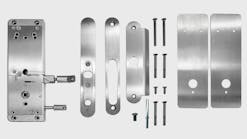Doors and gates that provide a path of egress must provide a code-compliant means of evacuation as well as meet accessibility standards.
Generally, egress doors and gates are required to unlatch with one releasing motion, by using no key, tool, special knowledge or effort, and with no tight grasping, pinching or twisting of the wrist. In most jurisdictions, the releasing hardware must be mounted between 34 inches and 48 inches above the floor. Other accessibility considerations include those that apply to clear opening width and height, maneuvering clearance, door-opening force, operable force for hardware and threshold height.
Doors and gates that serve swimming pools are subject to many of the same requirements for egress and accessibility that apply to other doors and gates. They’re an important part of the means of egress for the pool as well as the pool deck and other areas that surround the pool.
Mounting Heights
One key difference for swimming pool doors and gates is the allowable mounting height of the releasing hardware. This is because of the concern that young children might attempt to access a pool area unaccompanied. The codes and standards allow the hardware to be mounted higher to make it more difficult for small children to operate the hardware on their own.
The International Building Code (IBC) defines a swimming pool as: “Any structure intended for swimming, recreational bathing or wading that contains water over 24 inches (610mm) deep. This includes in-ground, above-ground and on-ground pools; hot tubs; spas and fixed-in-place wading pools.” For facilities that are required to comply with the IBC, the referenced standard for pools, spas and hot tubs is the International Swimming Pool and Spa Code (ISPSC). State or local requirements also might apply to pools within a particular jurisdiction, so it’s important to be familiar with the adopted codes that apply in a given location.
An exception in the IBC addresses the mounting height of hardware on doors and gates that serve swimming pools, spas and hot tubs, stating: “Access doors or gates in barrier walls and fences protecting pools, spas and hot tubs shall be permitted to have operable parts of the latch release on self-latching devices at 54 inches (1,370mm) maximum above the finished floor or ground, provided that the self-latching devices are not also self-locking devices operated by means of a key, electronic opener or integral combination lock.”
This exception allows operable hardware for pool doors and gates to be mounted 54 inches maximum above the floor or ground, but the terminology used in this exception has caused some confusion. The intent is that the exception can’t be applied, and the hardware mounted 54 inches above the floor, if the door or gate has self-latching, self-locking hardware that prevents unauthorized access from the outside. It would have been interpreted more easily if the exception stated that the 54-inch mounting height isn’t allowed or required when the hardware is self-latching and self-locking.
When the door or gate has a lock on the ingress side, the requirement for a key or access control credential provides the necessary level of child safety. This allows the hardware to be installed at a height that meets the accessibility requirements — typically 34–48 inches above the floor or ground. If the door or gate isn’t always locked on the ingress side, the increased mounting height is allowed — and required.
Changes Made
The detailed requirements for doors and gates that serve swimming pools were clarified in the 2021 edition of the ISPSC. Several changes were made to Section 305.3 – Doors and Gates, with some of the changes addressing the doors and gates themselves. For example:
- Doors and gates must be self-closing and outswinging (swinging away from the pool).
- Self-latching doors and gates are required — pairs may have one leaf that’s bolted or fixed and one self-latching leaf.
- No openings of more than one-half of an inch are allowed within 18 inches of the latch. This helps to prevent children from retracting the latch from the outside.
- Service doors in the pool area must be locked when the utility rooms aren’t in use.
- Equipment-room doors must have an “automatic closer” and an “automatic lock” (a door closer that doesn’t have a hold-open mechanism and a storeroom function lockset, for example).
The Latch Release section of the ISPSC has been modified for clarity, with regard to the operable hardware. The allowable mounting height for the hardware depends on whether the door or gate always is locked or can be left unlocked and whether the door serves a public, residential or private pool.
A public pool is one that’s intended to be used for swimming and is operated by an owner, lessee, operator, licensee or concessionaire, with or without a fee for use. Public pools are classified further in the ISPSC depending on how they’re used. For example, pools used for competitive diving events would be a different class from water slides or leisure rivers.
Residential pools are an accessory to a residence and available only to the household and its guests.
The ISPSC doesn’t define a private pool, so this leaves some room for interpretation. When terms aren’t defined in the code, the dictionary definition applies. Merriam-Webster defines “private” as: “intended for or restricted to the use of a particular person, group or class, or belonging to or concerning an individual person, company or interest.” Some state and local codes include specific language that defines private pools, but without a definition in the ISPSC it’s left to the Authority Having Jurisdiction (AHJ) to determine whether a pool is private.
Lock Rules
If a door or gate has self-latching hardware that always requires a key or access control credential to enter, it’s considered to be self-locking. The mounting height ranges shown below apply to the latch-release mechanism and the “lock operation control,” such as an access control reader. If a door or gate has hardware that isn’t lockable or might be left unlocked on the ingress side, it’s considered to be nonself-locking.
In the 2021 edition of the ISPSC, the allowable mounting heights for operable hardware are as follows:
Self-locking doors or gates
- Public pools or spas: 34–48 inches above the finished floor (AFF)
- Residential pools or spas: not more than 54 inches AFF
Nonself-locking doors or gates
- Public pools or spas: 52–54 inches AFF
- Residential pools or spas: not less than 54 inches AFF
- Private pools or spas: release mechanism at least 3 inches below top of gate on pool side
Along with addressing security and accessibility for swimming pools, egress is an important consideration. Some swimming pool enclosures are large enough for the doors and gates to require panic hardware. This would apply to pools that are considered to be assembly occupancies, based on a calculated occupant load of the pool and the pool deck within the enclosure.
When the occupant load of the area within the pool enclosure is 50 people or more, the IBC requires the doors that serve the pool area to have panic hardware. For jurisdictions that enforce NFPA 101 – Life Safety Code, panic hardware is required when the occupant load of the pool area is more than 100 people. Both limits apply to doors and gates equipped with a lock or latch. In some cases, pool doors and gates are equipped with access control hardware, which might have additional requirements depending on the type of electrified hardware installed.
Following the requirements of the ISPSC, along with the adopted building codes, fire codes and accessibility standards, will help to ensure that doors and gates that serve swimming pools provide the necessary levels of safety and accessibility. Be sure to check for local modifications to these requirements or contact the AHJ for assistance.
Lori Greene, DAHC/CDC, CCPR, FDAI, FDHI, is manager, codes and resources at Allegion. Visit her website, idighardware.com.

Lori Greene, DAHC/CDC, CCPR, FDAI, FDHI
Lori Greene, DAHC/CDC, CCPR, FDAI, FDHI, is manager, codes and resources at Allegion. Visit her website, idighardware.com.






